- Best varieties of radishes for autumn sowing
- Best varieties of daikon for autumn sowing
- Proper soil preparation for autumn sowing
- 1. Clear the area
- 2. Loosen the soil
- 3. Remove rocks and large clumps
- 4. Add organic matter
- 5. Adjust soil pH
- 6. Level the soil
- 7. Water the soil
- 8. Mark rows or beds
- Tips for successful autumn sowing of radishes and daikon
- Timing and temperature requirements for autumn sowing
- Sowing time
- Temperature requirements
- Common pests and diseases affecting radishes and daikon
- Pests
- Diseases
- Harvesting and storage of autumn-sown radishes and daikon
- Harvesting:
- Storage:
- Tips:
- “Question-Answer”
- Is it possible to sow radishes and daikon in autumn?
- What are the best varieties of radishes for autumn sowing?
- Can daikon be grown in colder climates?
- What are some tips for planting radishes and daikon in autumn?
- How long does it take for radishes and daikon to mature after autumn sowing?
- What are some common pests and diseases that affect radishes and daikon?
- Can radishes and daikon be grown in containers?
- “Video” How to Grow Full Size Radishes and Not Just Leaves: 4 Tips, Planting, Harvest & Proof
Autumn is the perfect time to sow radishes and daikon, as these root vegetables thrive in cooler temperatures. With the right varieties and planting tips, you can enjoy a bountiful harvest of crisp and peppery radishes or large and mild daikon. In this article, we will explore the best varieties for autumn sowing and provide you with some essential tips to ensure a successful growing season.
When it comes to radishes, the fall season offers a wide range of options. One of the top choices for autumn sowing is the French Breakfast variety. This elongated radish has a beautiful two-tone coloration, with a bright red top and a white base. Its mild and slightly spicy flavor makes it a popular choice for salads and sandwiches. Another great option is the Watermelon radish, known for its stunning appearance with a green exterior and a bright pink center. It has a slightly sweet and peppery taste that adds a unique twist to any dish.
If you’re looking for something larger, daikon is the perfect choice. This long and cylindrical root vegetable is commonly used in Asian cuisine and can be enjoyed raw, pickled, or cooked. One of the best daikon varieties for autumn sowing is the Miyashige White daikon. It has a crisp texture and a mild flavor, making it versatile in various dishes. The Minowase Summer Cross daikon is another excellent option, known for its large size and sweet taste.
Now that you have chosen the right varieties, it’s time to start planting. Radishes and daikon prefer well-drained soil with a pH level between 5.8 and 6.8. Prepare the soil by removing any weeds and loosening it with a garden fork or tiller. Sow the seeds directly into the ground, spacing them according to the variety’s recommendations. For radishes, thinning is crucial to ensure proper growth, so be sure to remove any overcrowded seedlings. Water the plants regularly, keeping the soil consistently moist but not waterlogged. Harvest your radishes when they reach the desired size, usually within 20-30 days after sowing.
With these best varieties and planting tips, you will be well-equipped to enjoy a successful autumn sowing of radishes and daikon. Experiment with different recipes and savor the fresh and crunchy flavors that these root vegetables bring to your table.
Best varieties of radishes for autumn sowing
Radishes are a popular vegetable to grow in the autumn due to their quick maturation time and resistance to colder temperatures. There are various varieties of radishes that are suitable for autumn sowing, each with its own unique characteristics and flavors. Here are some of the best varieties to consider:
- French Breakfast: This classic radish variety has an elongated shape and a beautiful red and white color combination. It has a mild, slightly spicy flavor, making it perfect for adding a kick to salads and sandwiches.
- Cherry Belle: Known for its round, bright red roots, Cherry Belle is a popular choice for autumn sowing. It has a crisp texture and a mild, sweet flavor, making it enjoyable to eat both raw and cooked.
- Watermelon: As the name suggests, Watermelon radishes have a vibrant, green exterior with a bright pink to red interior that resembles a watermelon. They have a mild, slightly peppery taste and add a pop of color to any dish.
- Easter Egg: This radish variety gets its name from the assortment of colors it comes in, ranging from white to pink, purple, and red. Easter Egg radishes have a mild, refreshing flavor and are great for adding visual interest to salads.
These are just a few examples of the best radish varieties for autumn sowing. Experiment with different types to find the flavors and colors that you enjoy the most. Remember to sow them at the right time and provide adequate care to ensure a successful harvest.
Best varieties of daikon for autumn sowing
Daikon, also known as white radish or winter radish, is a popular vegetable to grow during the autumn season. It is known for its long and slender shape, crisp texture, and mild peppery flavor. Here are some of the best varieties of daikon that you can consider planting during autumn:
- Tokinashi: This Japanese variety of daikon is well-suited for autumn sowing. It has a smooth white skin, tender flesh, and a mild flavor. It grows to a length of about 18 inches and can be harvested in about 60-70 days.
- Minowase: Also known as Giant Japanese, this daikon variety is a favorite among gardeners. It has a long and cylindrical shape with a white exterior. It has a sweet and juicy flesh, making it perfect for salads and pickling. It usually matures in about 50-60 days.
- Shunkyo: This daikon variety has a unique appearance with its tapered shape and vibrant pink color. It has a crisp texture and slightly spicy flavor. It is commonly used in Asian dishes and can be harvested in about 40-50 days.
When selecting daikon seeds for autumn sowing, it is important to consider the maturity time, as it should be able to reach maturity before the first frost. It is also recommended to choose varieties that are disease-resistant and adaptable to your local growing conditions.
Remember to sow the daikon seeds directly into the ground, preferably in a well-draining soil that is rich in organic matter. Sow the seeds about ½ inch deep and space them about 4-6 inches apart. Regularly water the plants and provide them with enough sunlight for optimal growth.
By choosing the right variety and following proper planting techniques, you can enjoy a bountiful harvest of daikon during the autumn season.
Proper soil preparation for autumn sowing
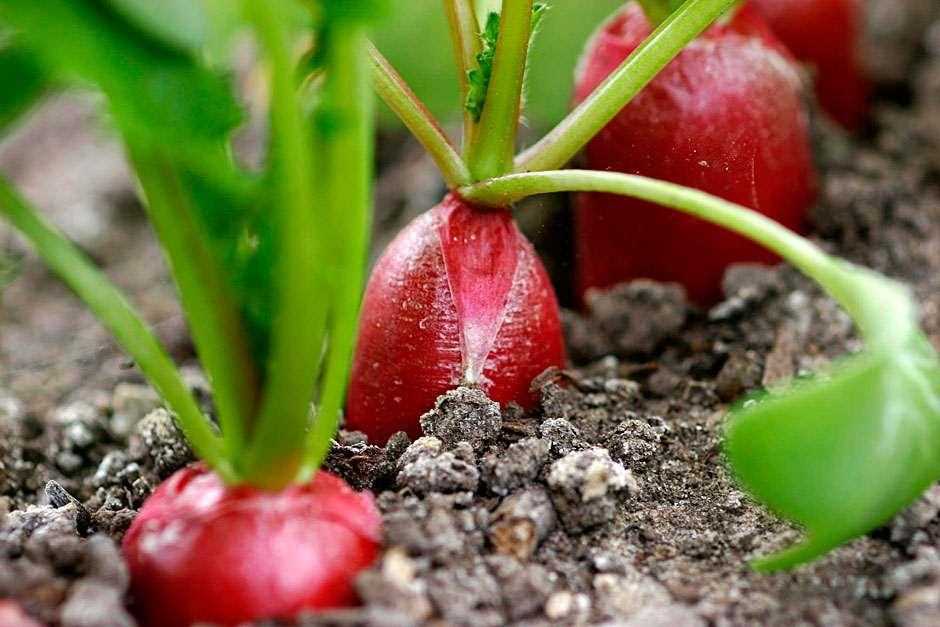
Proper soil preparation is crucial for successful autumn sowing of radishes and daikon. By preparing the soil correctly, you can provide the optimal conditions for seed germination and plant growth. Here are some important steps to follow:
1. Clear the area
Start by clearing the area of any weeds, debris, or existing plants. This will ensure that the radishes and daikon have enough space to grow without competition for nutrients and sunlight.
2. Loosen the soil
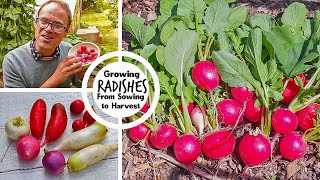
Use a garden fork or tiller to loosen the soil. This will help create a loose, well-draining environment for the seeds. Avoid compacted soil, as it can hinder the radishes and daikon from forming good roots.
3. Remove rocks and large clumps
Take the time to remove rocks and large clumps of soil. These can interfere with root growth and make it difficult for the seeds to establish themselves. Smooth out the surface of the soil as much as possible.
4. Add organic matter
Improve the fertility of the soil by adding organic matter such as compost or well-rotted manure. This will provide essential nutrients that the radishes and daikon need to thrive. Spread a layer of organic matter over the surface of the soil and work it in with a garden fork.
5. Adjust soil pH
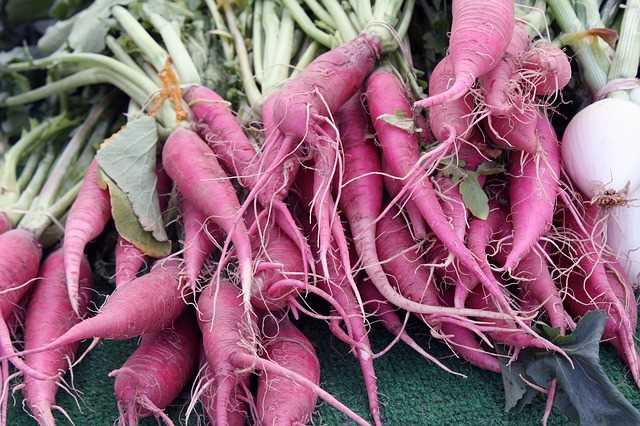
Test the soil pH and adjust it if necessary. Radishes and daikon prefer a slightly acidic to neutral pH range of 6.0 to 7.0. If the soil pH is too high or too low, you can make the necessary adjustments by adding lime to raise the pH or elemental sulfur to lower the pH.
6. Level the soil
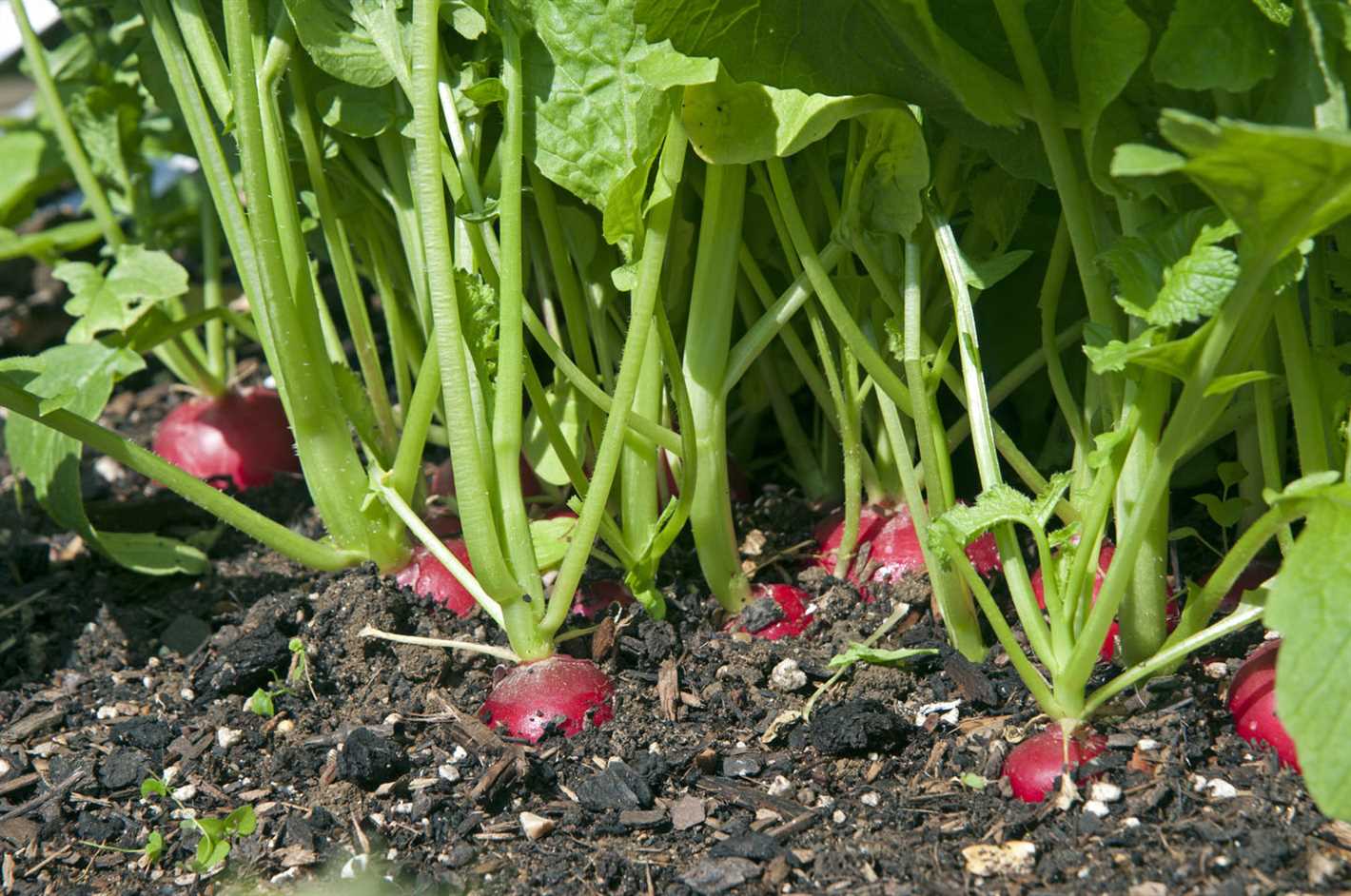
Rake the soil to level it and create a smooth surface. This will make it easier to sow the seeds evenly and ensure consistent germination and growth.
7. Water the soil
Before sowing the seeds, water the soil thoroughly. This will help settle the soil and provide moisture for the seeds to sprout. Avoid over-watering, as excessive moisture can lead to rotting of the seeds.
8. Mark rows or beds
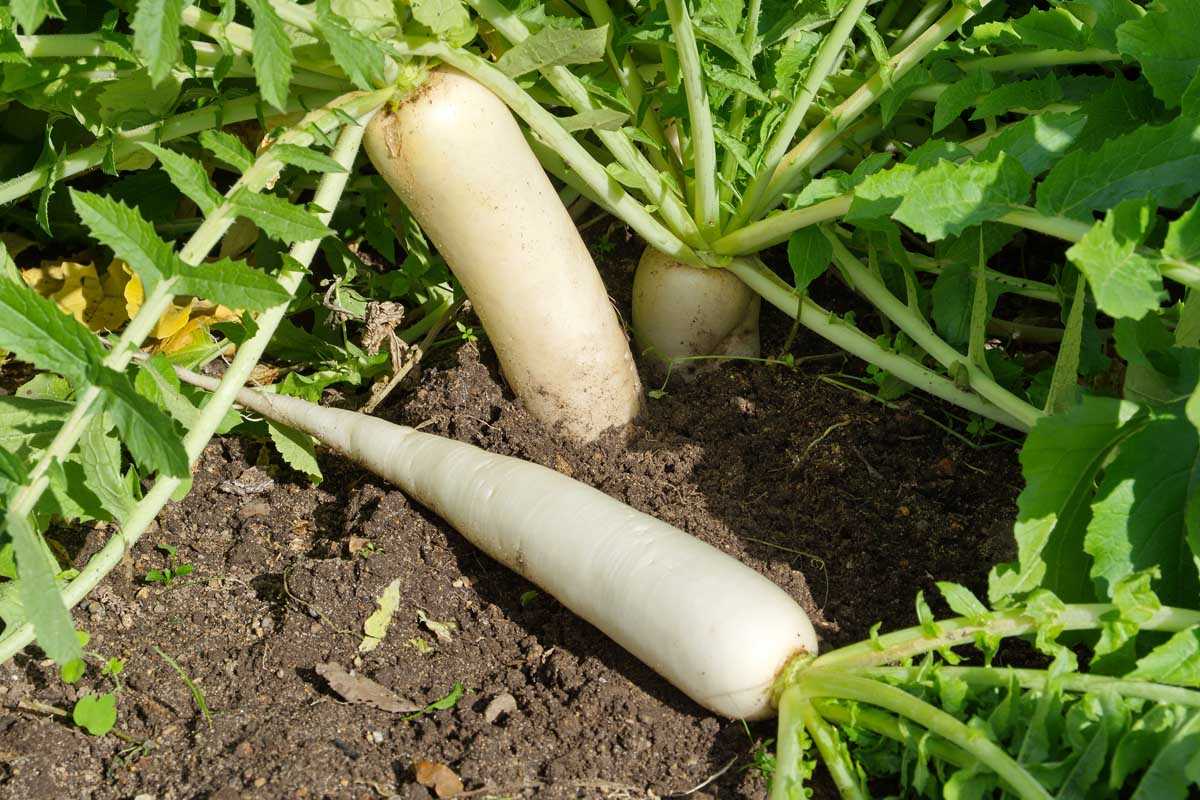
Use stakes or string to mark rows or beds for planting. This will help you sow the seeds in straight lines and make it easier to identify the seedlings as they emerge.
Following these soil preparation steps will create a favorable environment for radishes and daikon to grow and develop. Remember to choose the right varieties and follow proper planting techniques for best results. Happy autumn sowing!
Tips for successful autumn sowing of radishes and daikon
- Choose the right varieties: When sowing radishes and daikon in autumn, it is important to select varieties that are suitable for cooler temperatures and have a shorter maturity period. Some popular varieties for autumn sowing include Cherry Belle and French Breakfast for radishes, and Miyashige and White Icicle for daikon.
- Prepare the soil: Before sowing, prepare the soil by removing any weeds, rocks, or debris and loosening it to a depth of about 6 inches. Mix in some organic matter like compost or well-rotted manure to improve the soil structure and fertility.
- Sow at the right time: Ideally, autumn sowing of radishes and daikon should be done about 6-8 weeks before the first expected frost. This timing allows the plants to mature before the winter cold sets in. Check your local climate and gardening calendar to determine the best sowing time for your region.
- Planting depth and spacing: Radish seeds should be sown about ½ inch deep, while daikon seeds can be sown slightly deeper, around 1 inch. Space the seeds according to the recommendations on the seed packet, usually around 1-2 inches apart for radishes and 4-6 inches apart for daikon.
- Provide adequate water: Radishes and daikon require consistent moisture for successful germination and growth. Water the plants regularly, aiming for about 1 inch of water per week. Avoid overwatering, as it can lead to rotting or disease.
- Protect against pests: Radishes and daikon are relatively easy to grow, but they can still be susceptible to certain pests like flea beetles and cabbage worms. To protect your plants, cover them with a lightweight row cover or apply organic pest control methods, such as neem oil or insecticidal soap.
- Harvest at the right time: Radishes are typically ready for harvest within 3-4 weeks, while daikon may take 6-8 weeks. The roots should be firm and crisp, with good color and flavor. Harvest the radishes when they reach the desired size, usually around 1-2 inches in diameter. For daikon, wait until they are 8-12 inches long and about 2 inches in diameter.
Timing and temperature requirements for autumn sowing
Autumn is the perfect time to sow radishes and daikon as these cool-season crops thrive in cooler weather. The timing for autumn sowing depends on the specific variety you are planting and your local climate.
Sowing time
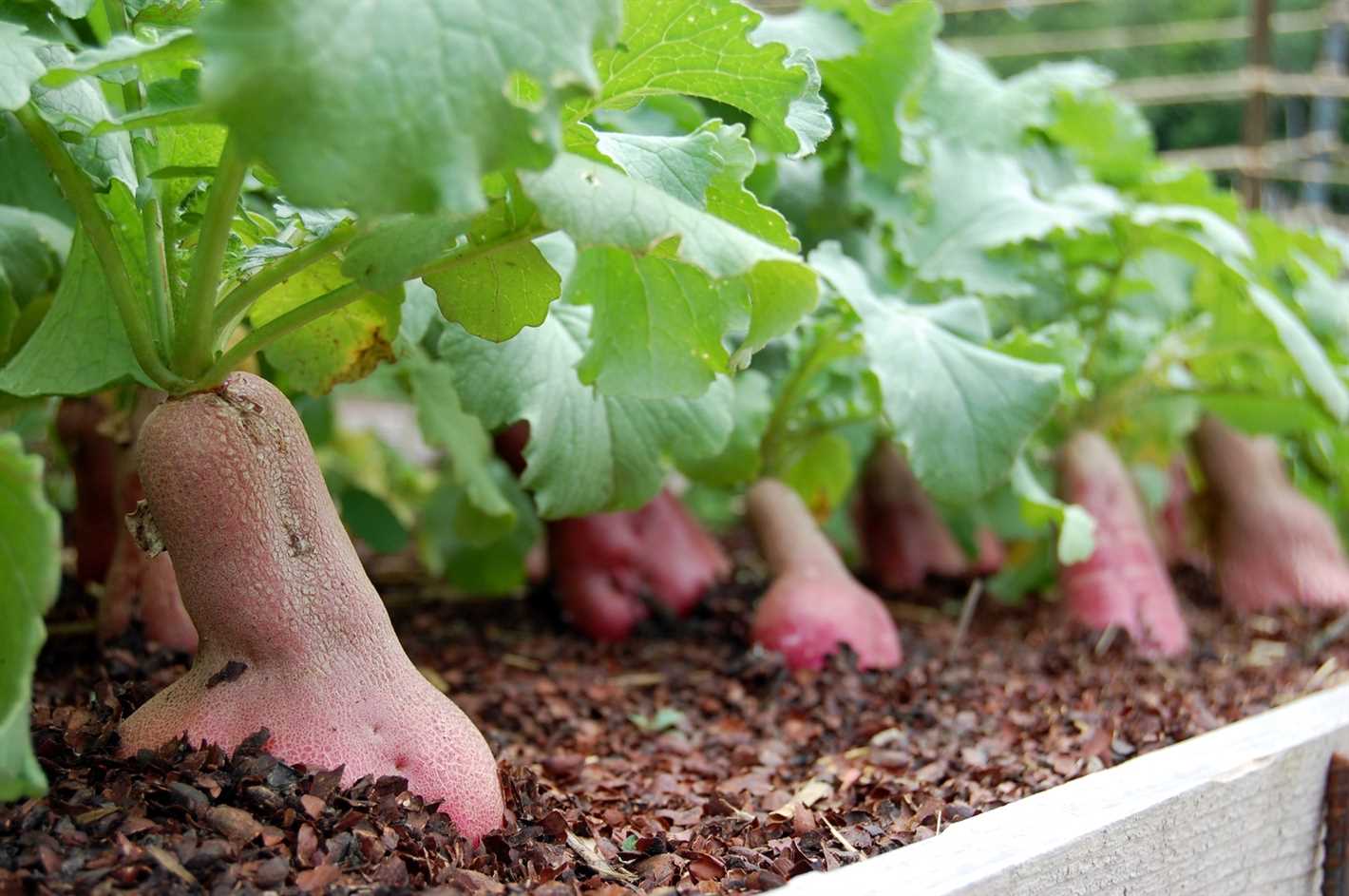
For most radish varieties, you can start sowing in late summer or early autumn, typically around August or September. It is important to consider the number of days to maturity for the specific variety you are planting. This will help you calculate the ideal time to sow, so you can harvest your radishes before the first frost in your area.
Daikon radishes, on the other hand, take longer to mature. They can be sown in mid to late summer, usually around July or August, to ensure they have enough time to grow before the winter sets in.
Temperature requirements
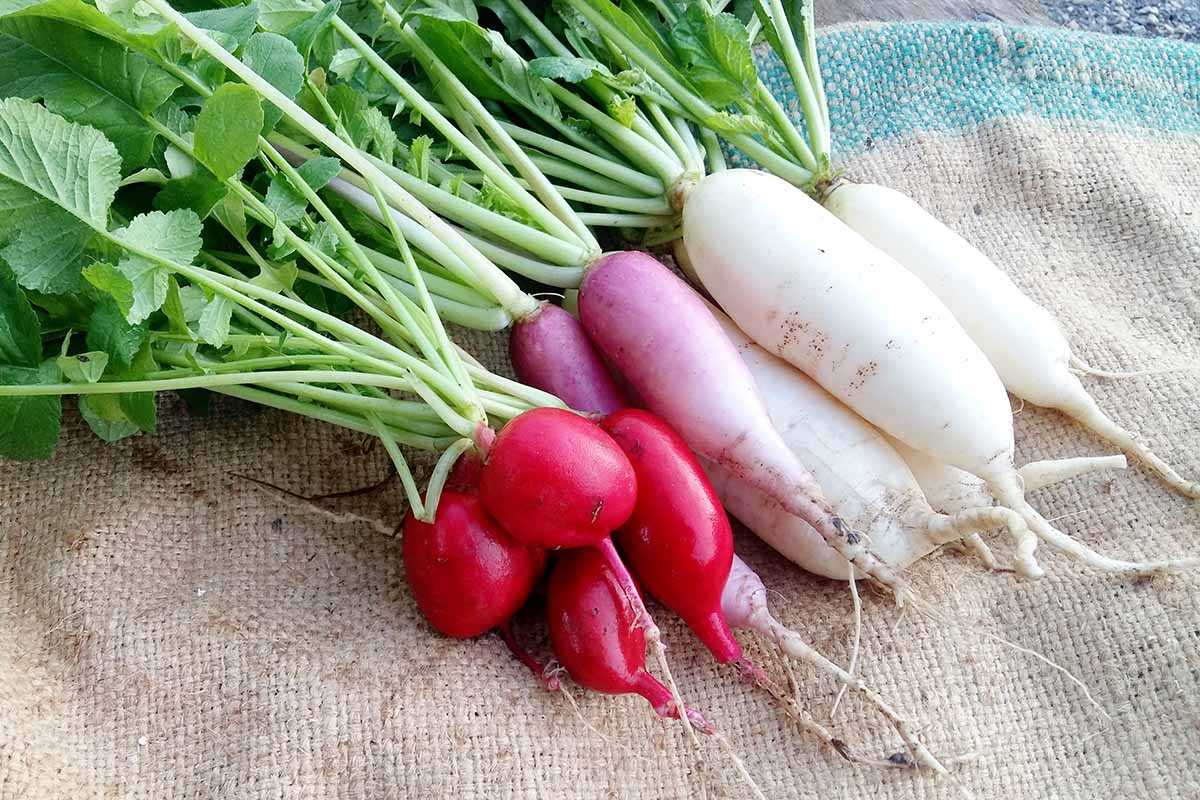
Radishes and daikon thrive in cooler temperatures, and their growth can be stunted in hot weather. The ideal soil temperature for germination is between 50°F and 65°F (10°C and 18°C). If the soil temperature is too high, the seeds may not germinate or the plants may bolt, resulting in poor root development.
It is important to monitor the temperature and adjust your sowing schedule accordingly. If the weather is still hot in your area during the recommended sowing time, you can start the seeds indoors and transplant them outdoors when the temperatures cool down.
Once the radishes and daikon are established, they can tolerate lower temperatures and even light frosts. This makes them well-suited for autumn sowing. However, if you are expecting severe frosts, consider covering your plants with row covers or mulch to protect them.
By sowing your radishes and daikon at the right time and in the right temperature conditions, you can ensure a successful autumn harvest of these delicious root vegetables.
Common pests and diseases affecting radishes and daikon
Radishes and daikon can be affected by a variety of pests and diseases. Here are some of the most common ones to watch out for:
Pests
- Flea beetles: These small, jumping beetles can cause extensive damage to radish crops by feeding on the leaves and causing small holes. To control flea beetles, consider using row covers or applying organic insecticides.
- Cabbage root flies: These flies lay their eggs near the base of young radishes and daikon, and the emerging larvae feed on the roots, causing stunted growth and wilting. To prevent infestation, use row covers and monitor for signs of damage.
- Slugs and snails: These slimy pests feed on radish leaves, causing irregularly shaped holes and leaf damage. To control slugs and snails, consider using slug traps, beer traps, or organic slug pellets.
Diseases
- Clubroot: This soil-borne disease affects radishes and daikon by causing swollen, distorted roots and stunted growth. To prevent clubroot, practice crop rotation, select resistant varieties, and maintain proper soil pH.
- Downy mildew: This fungal disease appears as yellow patches on the leaves, which eventually turn brown and die. To prevent downy mildew, provide good air circulation, avoid overhead watering, and remove infected plants promptly.
- Root rot: This disease is caused by various fungi and bacteria, resulting in rotting roots and stunted growth. To prevent root rot, ensure proper drainage, avoid overwatering, and plant in well-draining soil.
By being aware of these common pests and diseases, you can take proactive measures to protect your radish and daikon crops and ensure a successful harvest.
Harvesting and storage of autumn-sown radishes and daikon
Once your radishes and daikon have reached maturity, it’s time to harvest them. Here are some tips on how to properly harvest and store your autumn-sown radishes and daikon:
Harvesting:
- Harvest your radishes and daikon when they have reached the desired size. You can check the size by gently pulling on the leaves to see if the roots have developed.
- Use a garden fork or spade to carefully lift the radishes and daikon out of the ground. Be careful not to damage the roots.
- Remove any excess soil from the roots and gently twist off the leaves. You can keep the leaves for use in salads or other dishes.
Storage:
- If you plan to use your radishes and daikon immediately, wash them thoroughly and store them in a cool, dark place until you are ready to use them.
- If you want to store your radishes and daikon for a longer period of time, trim the tops to about 1 inch from the root and remove any damaged or bruised roots.
- Place the cleaned radishes and daikon in a perforated plastic bag or airtight container. This will help to maintain their freshness while allowing some air circulation.
- Store the radishes and daikon in the refrigerator at a temperature of around 32 to 40°F (0 to 4°C).
- Radishes can be stored for up to two weeks, while daikon can be stored for up to two months.
Tips:
- Harvest radishes and daikon as needed to ensure that you have a fresh supply throughout the season.
- Inspect your stored radishes and daikon regularly for any signs of spoilage or decay. Remove any affected roots to prevent spreading.
By following these harvesting and storage tips, you can enjoy the fresh and flavorful taste of autumn-sown radishes and daikon for an extended period of time.
“Question-Answer”
Is it possible to sow radishes and daikon in autumn?
Yes, it is possible to sow radishes and daikon in autumn. In fact, autumn sowing can be beneficial as it allows the plants to establish before winter and produce an early harvest the following spring.
What are the best varieties of radishes for autumn sowing?
Some of the best varieties of radishes for autumn sowing include ‘Sparkler’, ‘Cherry Belle’, ‘French Breakfast’, and ‘Easter Egg’. These varieties are known for their fast growth, crisp texture, and excellent flavor.
Can daikon be grown in colder climates?
Yes, daikon can be grown in colder climates. There are certain varieties of daikon that are more cold-tolerant, such as ‘Snow Belle’ and ‘Alpine’. These varieties can withstand colder temperatures and are suitable for autumn sowing.
What are some tips for planting radishes and daikon in autumn?
When planting radishes and daikon in autumn, it is important to choose a sunny spot with well-drained soil. The seeds should be sown directly into the ground, about half an inch deep, and spaced about one inch apart. Regular watering is necessary to ensure proper growth and development.
How long does it take for radishes and daikon to mature after autumn sowing?
The time it takes for radishes and daikon to mature after autumn sowing can vary depending on the variety and growing conditions. However, on average, radishes can be harvested in about 3 to 4 weeks, while daikon may take around 60 to 70 days to reach maturity.
What are some common pests and diseases that affect radishes and daikon?
Some common pests that can affect radish and daikon plants include flea beetles, root maggots, and aphids. Diseases such as damping off, powdery mildew, and clubroot can also be problematic. Proper pest management and disease prevention techniques, such as crop rotation and regular inspection, are important to ensure healthy plant growth.
Can radishes and daikon be grown in containers?
Yes, radishes and daikon can be grown in containers. It is important to choose a container with good drainage and a sufficient depth for root development. Varieties that are suited for container gardening, such as ‘Cherry Belle’, ‘French Breakfast’, and ‘Snow Belle’, can be sown in containers with well-draining potting soil.







